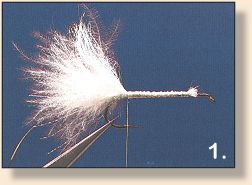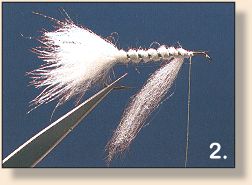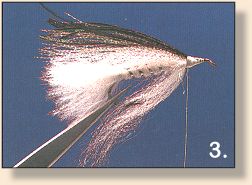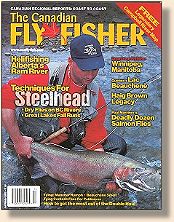Tradition and Innovation
The Beauchêne Smelt
By Sheldon Seale
A new variation developed at Lac Beauchêne
The Beauchêne Smelt is a variation of the better
known McNally Smelt. It was developed by Mark Heaton
of the Ontario Ministry of Natural Resources while we
were fishing together for brook trout at La Réserve
Beauchêne in Quebec. It proved effective. In fact,
Mark outfished me with that pattern rather badly. However,
in my defense, he is a fisheries biologist and is supposed
to understand the predator/prey relationship better than
I do.
Materials:
Hook: 2X or 3X long nymph, sizes 2 and 4.
Thread: White.
Tail: White marabou under white Polaraire with
pearlescent Krystalflash on the sides.
Rib: Silver tinsel.
Body: Cream rabbit with some sparkle in it or similar.
Throat: White Polaraire, to the end of the wing.
Wing: White Polaraire under pearlescent Krystalflash
under gold Kyrstalflash, topped by peacock herl.
Sides: Grizzly saddle (1 feather on each side).
Head: White thread, tied somewhat oversized and coated
with 5 minute epoxy.
Eyes: White 3D eyes with black pupils epoxied into place.

1. Tie in the tail in layers starting with the white marabou
over which is white Polaraire. Add about 6 or 7 strands of
pearlescent Kryatalflash to each side. The overall length
of the tail is about equal to the hook shank. Finally, tie
the ribbing in place for the next step.

2. Dub a body of cream dubbing and wind the ribbing forward.
Add a long throat (reaching to the end of the tail). Keep
the amount of material fairly sparse.

3. Tie in the wing in layers starting with the white
Polaraire. Then add the pearlescent Krystalflash, the
gold Krystalflash, and top with a few strands of peacock
herl. Don't overdress the fly. The idea is to form a
long, slender profile.

4. Add the grizzly saddle hackle sides to about 3/4 of
the overall wing length. Tie off a fairly large head and
coat with epoxy. If you are just adding the eyes, put
them in place white the epoxy is still wet.
Fishing notes:
 Large fish species that feed heavily on other fishes, like
large meals. Brook trout are no exception, and the brook
trout in Beauchêne grow big (up to over seven pounds).
They'll feed on large larva such as dragonflies and
hexagenis - even on crayfish. But we
weren't surprised to find them targeting smelt, as
these provide a much more substantial mouthful. Smelt
prefer cold water and tend to go deep if the surface
layers of water warm even a little. Therefore, even
in the early season, they're usually best fished deep - down
10 feet or more. A full sinking line or fast sinking
shooting head system will help you get your imitation
down quickly to where the brookies expect to find the
naturals. Deep water close to heavy cover usually provide
the most action. At Beauchêne in May our bigger
fish were frequently associated with larger sunken timber,
particularly deadfalls angling from steep banks. ~ Sheldon Seale
Large fish species that feed heavily on other fishes, like
large meals. Brook trout are no exception, and the brook
trout in Beauchêne grow big (up to over seven pounds).
They'll feed on large larva such as dragonflies and
hexagenis - even on crayfish. But we
weren't surprised to find them targeting smelt, as
these provide a much more substantial mouthful. Smelt
prefer cold water and tend to go deep if the surface
layers of water warm even a little. Therefore, even
in the early season, they're usually best fished deep - down
10 feet or more. A full sinking line or fast sinking
shooting head system will help you get your imitation
down quickly to where the brookies expect to find the
naturals. Deep water close to heavy cover usually provide
the most action. At Beauchêne in May our bigger
fish were frequently associated with larger sunken timber,
particularly deadfalls angling from steep banks. ~ Sheldon Seale
Credits: This article is from the
Canadian Fly Fisher magazine. We appreciate use permission!
Our Man In Canada Archives
|

